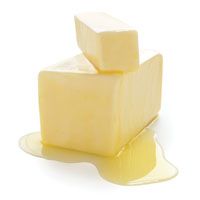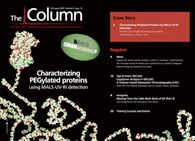I can't believe it's not diesel
The search for new raw materials for making biodiesel fuel has led scientists to an unlikely farm product - butter.

The search for new raw materials for making biodiesel fuel has led scientists to an unlikely farm product - butter. Biodiesel production is now approaching 1 billion gallons annually in the US and is expected to go up as demand for eco-friendly fuel sources increases. To keep the costs of biodiesel production down, a range of low cost sources are being considered and according to a report in the Journal of Agricultural and Food Chemistry leftover butter could be used.1
Biodiesel consists of the simple fatty acids methyl esters (FAME) derived from vegetable and animal fats and oils. Through melting, catalysation and separation, 287.7 L of FAME was collected from 348.2 L of butter. HPLC was used to confirm the results to be essentially pure FAME. After a series of official biodiesel quality control tests, including GC methods, the fuel met all but one of the test standards, showing the potential for excellent ignition qualities, good cold-starting performance and reduced smoke emissions. The study concluded that with further purification or by blending with biodiesel from other feedstocks, butter biodiesel could add to the supply of bio‑based fuel for diesel engines.
1. M.J. Haas et al., J. Agric. Food Chem., 58(13),7680-7684 (2010).
This story originally appeared in The Column. Click here to view that issue.

Best of the Week: Food Analysis, Chemical Migration in Plastic Bottles, STEM Researcher of the Year
December 20th 2024Top articles published this week include the launch of our “From Lab to Table” content series, a Q&A interview about using liquid chromatography–high-resolution mass spectrometry (LC–HRMS) to assess chemical hazards in plastic bottles, and a piece recognizing Brett Paull for being named Tasmanian STEM Researcher of the Year.
Using LC-MS/MS to Measure Testosterone in Dried Blood Spots
December 19th 2024Testosterone measurements are typically performed using serum or plasma, but this presents several logistical challenges, especially for sample collection, storage, and transport. In a recently published article, Yehudah Gruenstein of the University of Miami explored key insights gained from dried blood spot assay validation for testosterone measurement.
Determination of Pharmaceuticals by Capillary HPLC-MS/MS (Dec 2024)
December 19th 2024This application note demonstrates the use of a compact portable capillary liquid chromatograph, the Axcend Focus LC, coupled to an Agilent Ultivo triple quadrupole mass spectrometer for quantitative analysis of pharmaceutical drugs in model aqueous samples.